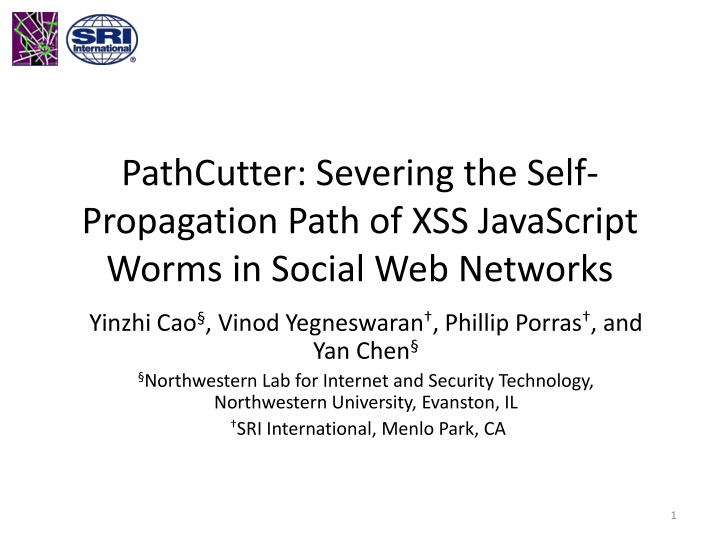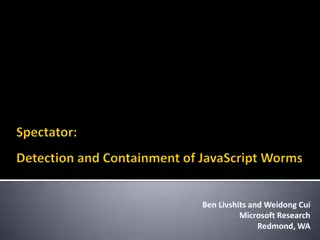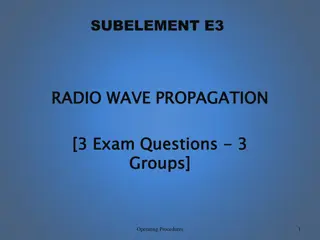Severing the Self-Propagation Path of XSS JavaScript Worms
Social web networks face severe XSS worm threats, as demonstrated by cases like MySpace Samy. This paper introduces PathCutter, a method to prevent XSS worm propagation by implementing view separation and request authentication. The roadmap covers background, attack steps, XSS taxonomy, related work, and the proposed approach to combat XSS worms effectively.
Download Presentation

Please find below an Image/Link to download the presentation.
The content on the website is provided AS IS for your information and personal use only. It may not be sold, licensed, or shared on other websites without obtaining consent from the author.If you encounter any issues during the download, it is possible that the publisher has removed the file from their server.
You are allowed to download the files provided on this website for personal or commercial use, subject to the condition that they are used lawfully. All files are the property of their respective owners.
The content on the website is provided AS IS for your information and personal use only. It may not be sold, licensed, or shared on other websites without obtaining consent from the author.
E N D
Presentation Transcript
PathCutter: Severing the Self- Propagation Path of XSS JavaScript Worms in Social Web Networks Yinzhi Cao , Vinod Yegneswaran , Phillip Porras , and Yan Chen Northwestern Lab for Internet and Security Technology, Northwestern University, Evanston, IL SRI International, Menlo Park, CA 1
Introduction Social web networks Platforms where people share their perspectives, opinions, thoughts and experiences OSNs, Blogs, Social bookmarking etc. XSS worm threat is severe. First worm: MySpace Samy (2005) More and more prevalent: Renren, Yamanner, etc. Akin to virus: human need to visit infected pages Characteristic: Fast spreading In this paper, Target: Prevent XSS worm propagation Method: View separation & Request authentication (Social Networks XSS Worms, Faghani et al.) Number of infected clients after 20 hours 2
Roadmap Introduction Background Attack Steps XSS Taxonomy Related Work Our Approach Implementation Evaluation 3
Background Step 1 Enticement and Exploitation Step 2 Privilege Escalation Step 3 Replication Step 4 Propagation Samy s page Download Modify benign user s account Repeat Process Other Users Get infected Benign User 4
XSS Taxonomy XSS Attacks Server-side XSS Client-side XSS Plugin XSS Content Sniffing XSS Reflected XSS DOM-based XSS Stored XSS MySpace Samy Worm Yamanner Worm Java XSS Flash XSS Our Experimental Worm Renren Worm SpaceFlash Worm 5
Related Work Group one: Prevent XSS vulnerabilities Incomplete coverage (BluePrint, Plug-in Patches, Barth et al., and Saxena et al.) Group two: Prevent XSS worms No early-stage prevention (Spectator and Xu et al.) Not resistant to polymorphic worm (Sun et al.) Our goal: Prevent all the XSS worms with early-stage prevention and resistance to polymorphic worms 6
Our Approach Two key concepts: (1) request authentication and (2) view separation We use request authentication. Download View separation is always enforced. Modify benign user s account Access Samy s page Benign User 7
View Separation For example, blog A, blog B, blog C and so on. Or more fine-grained, different pages in the same blog. Isolating contents from the same origin iframe tag with sandbox properties in HTML5 Pseudodomain encapsulation (mentioned later) View One View Two 8
Request Authentication For example, requests from blog A does not have permissions to modify blog B Identifying which view a client-side request is from. Secret token Referer header Check if the view has the permission 9
Our Approach View one does not have the permission. Identify that it is from View One. If we cannot identify, deny. Download Isolating views at client side. Modify benign user s account Access View One View Two Benign User 10
Roadmap Introduction Background Related Work Our Approach Implementation Implementation One (Server Modification) Implementation Two (Proxy) Evaluation Case Study of Five Real-world Worms and Two Experimental Worms (only two covered in the talk) Performance 11
Implementation One (Server Modification) Prototype examples: WordPress, Elgg Dividing views: by blogs Permissions for different views: can only modify its own blog. 12
View Isolation for Server Modification It cannot break isolate.x.com (different origin). Isolating views at client side. Pseudodomain encapsulation. isolate.x.com isolate.x.com content.x.com content.x.com attacker Secret token is required. content.x.com 13
Request Authentication for Server Modification Identifying requests from client-side Secret token Insertion position: Each request that will modify server- side contents. Checking requests permission Checking position: Database operation. (A narrow interface that each modifying request will go through.) 14
Implementation Two (Proxy) Dividing views: by different client-side URLs. Permissions for different views: Possible outgoing post URL from those URLs 15
View Isolation for Proxy Isolating views at client side The same as implementation one. Web Server Proxy isolate.x.com isolate.x.com Redirect to isolate.x.com <iframe src = content.x.com/y.php?t oken = *** content.x.com Request content.x.com/y.php 16
Request Authentication for Proxy Identifying requests from client-side Referer header Specified by the browser. Attackers cannot change it. Checking requests permissions Checking position: Proxy. Method: See if the view has the permission to send the request. 17
Case Study for Real World Worms XSS Worm in Renren (Facebook in China) Flash insert malicious scripts inside the web page Share on the behalf of current user 18
View One share View Two click Request to share 19
Yamanner Worm Click Send emails to all your contacts 20
Compose email Different views Email body Send email 21
Evaluation Memory Overhead Normally, # of frames is not high since comments can be hidden. Rendering Time Overhead. Less than 3.5% for Elgg 22
Conclusions We cut off the propagation path of XSS worms through view separation by psuedodomain encapsulation and request authentication. We implement PathCutter by proxy assistance and server modification. We evaluate PathCutter on 5 real-world worms and 2 proof-of-concept worms. 23
Thanks! Questions? 24
Backup 25
Comparison with Existing Works Group Two: Worm prevention Group One: Mitigating XSS Plug-in Patches Spectator Sun et al. Xu et al. BluePrint Barth et al. Saxena et al. PathCutter Blocking Step Polymorphic Worm 4 3 4 1 1 1 1 2 Yes No Yes Yes Yes Yes Yes Yes Early-Stage Prevention Types of XSS that Can Be Defended No Yes No Yes Yes Yes Yes Yes Passively Observable Worms Traditional Server-side XSS Worms Content Sniffing XSS Worms Plug-in XSS Worms DOM-Based XSS Worms All All All Server or Proxy Server or Proxy Deployment Client Server Server Client Client Client Passive/Active Monitoring Active Passive Passive Active Active Active Active Active 26
Limitation Need to know the semantics of web application Only prevent worm behavior but not all the damages 27
Existing solutions Spectator But it can only detect the worm when it spreads for a while! proxy if it reaches a threshold, report it. the same injected tag the same injected tag 28
Existing solutions Esorics 09 But (1) Payload may change. (2) Pure client-side solution. The same payload Deny! Firefox Plugin Payload: abcdefg Payload: abcdefg benign malicious 29
URL graph provided by the server or a third-party blogX/post-comment.php blogX/index.php blogX/options.php blogX/update- options.php blogX/x.php 30 blogY/index.php























